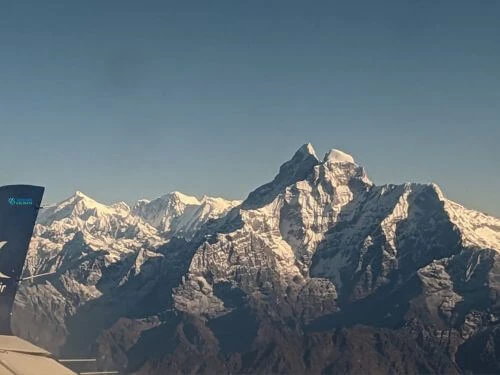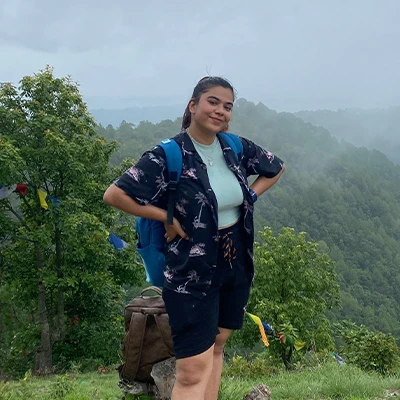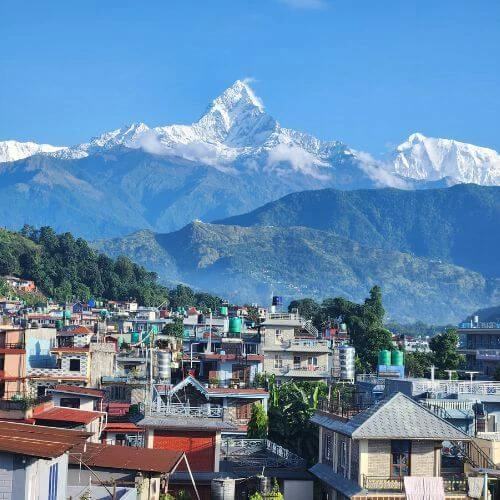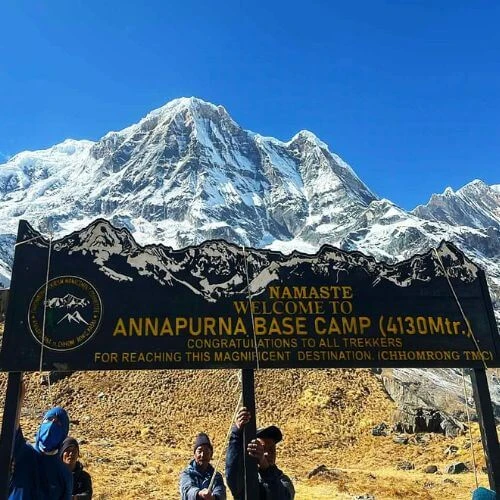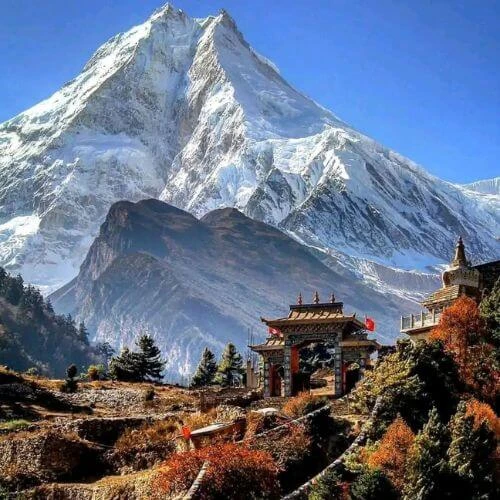Want to see the world’s highest mountain but can’t choose between an Everest Mountain Flight and the Everest Base Camp Trek? Both give you amazing views of Mount Everest, but they’re totally different experiences. One lets you fly over the Himalayas in about an hour, while the other takes you on a two-week adventure through Sherpa villages and wild mountain trails.
In this guide, we’ll compare Everest Mountain Flight and Everest Base Camp Trek by looking at cost, time, difficulty, altitude, and overall experience. So you can pick the adventure that matches your schedule, budget, and fitness level.
Quick Comparison - Mountain Flight vs Base Camp Trek
Here’s a quick side-by-side look to help you easily see the differences:
Feature | Everest Mountain Flight | Everest Base Camp Trek |
Duration | About 1 hour (round trip) | Around 12-14 days (standard trek) |
Cost | USD 200-250 per person | USD 1,200-2,000+ per person |
Difficulty | Super easy, no walking needed | Pretty tough, 5-7 hours of trekking every day |
Maximum Altitude | 6,000 m (flight height) | 5,364 m (Everest Base Camp) |
Experience Type | Cool scenic flight | Full-on adventure with culture and nature |
Photography | Window shots of Everest | Close-up views, monasteries, glaciers |
Best For | Short trips, families, and older people | Adventure lovers, hikers, and culture fans |
Trek Journey Snapshot
Check out the Everest adventure with an easy look at a mountain flight versus the full Everest Base Camp trek, showing how long they take, how active they are, and what you get to experience.
Everest Mountain Flight
- Duration: 1-2 hours round-trip from Kathmandu
- Route: Kathmandu to Lukla airspace to Himalayan range to close-up views of Everest and back to Kathmandu
- Activity Level: Very easy - just sit and enjoy the views
- Highlights: Amazing views of Everest, Lhotse, Ama Dablam, and other peaks; great spots for photos from the plane
- Ideal For: People with limited time, older travelers, families, or anyone who wants a quick and comfortable Himalayan experience.
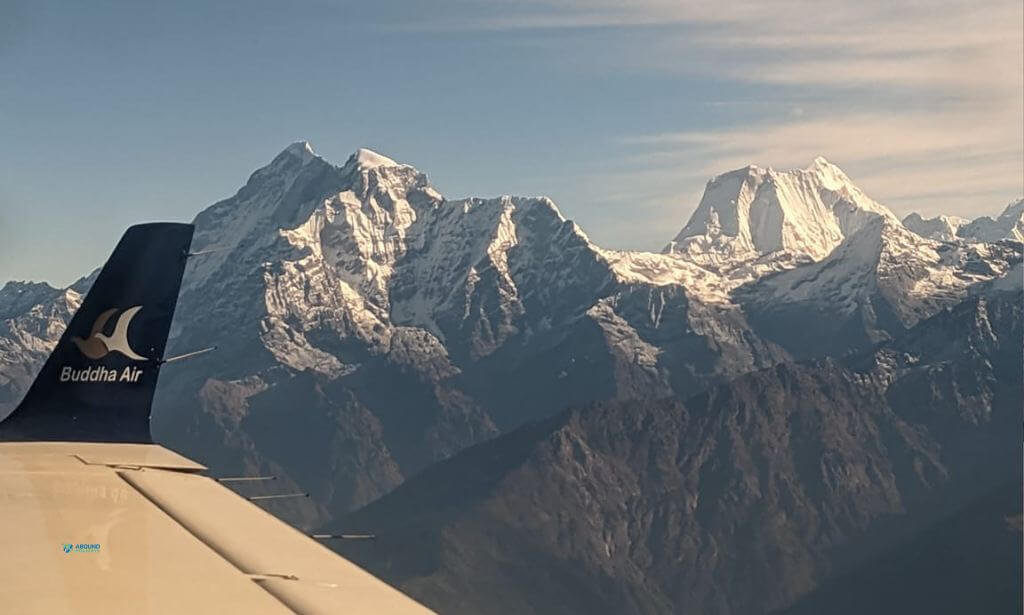
Everest Base Camp Trek
- Duration: 12-16 days (round trip from Lukla).
- Route: Lukla to Phakding to Namche Bazaar to Tengboche to Dingboche to Lobuche to Everest Base Camp to Kala Patthar and back to Lukla
- Activity Level: Medium to hard hiking of 4-8 hours a day, with rest days to adjust to the altitude.
- Highlights: Trek through Sherpa villages, visit Buddhist monasteries, see amazing Himalayan landscapes, reach Everest Base Camp, and enjoy epic views from Kala Patthar
- Ideal For: Adventure lovers, photographers, people who enjoy learning about culture, and anyone who wants a full trekking experience.
Detailed Comparison of Everest Mountain Flight vs Everest Base Camp Trek
Picking between an Everest Mountain Flight and the Everest Base Camp Trek isn’t easy. Both let you see Everest in awesome ways. One is a short flight with epic views, the other is a longer trek packed with adventure, culture, and mountain landscapes. Let’s dive into what makes each experience special.
Everest Mountain Flight Cost vs Trek Cost
How much money you can spend is a big deal when choosing between an Everest Mountain Flight and the Everest Base Camp Trek.
Everest Mountain Flight
A mountain flight usually costs about USD 200-250 per person. This typically includes:
- Round-trip flight from Kathmandu domestic airport.
- A guaranteed window seat for the views.
- Airport transfers (sometimes included).
Private vs Group Mountain Flight
Private Flight
- Flexible departure times
- Personalized service and more room
- Higher cost, best for families, couples on honeymoon, or people who want a luxury experience
Group Flight
- Budget-friendly option
- Sharing the experience with other travelers
- Less control over when you go and where you sit
Both options give the same amazing Himalayan views; pick one based on your budget and how much privacy you want.
Everest Base Camp Trek
Trekking to Everest Base Camp costs a lot more, usually around USD 1,200-2,000+ per person. The price generally includes:
- Flights from Kathmandu to Lukla (~USD 180-200 each way).
- Trekking permits (Sagarmatha National Park & TIMS Card, about USD 50 total).
- Accommodation and meals during the trek.
- Professional guides and porters.
- Emergency transport and insurance (optional but strongly recommended).

Which gives better value for money?
If you just want a quick look at Everest without spending too much time, the mountain flight is a great choice.
But if you’re after a full Himalayan adventure with culture, excitement, and a real sense of achievement, the trek is worth the higher price.
Book your adventure to the Everest region with Abound Holidays and travel to the Himalayas.
Duration - 1 Hour Flight vs 12-14 Days Trek
The amount of time you have makes a big difference when deciding on your Everest adventure. One is a quick flight, while the other is a longer trek that takes you deep into the mountains.
Everest Mountain Flight:
Great for short trips, this round-trip scenic flight takes about 1 hour. You’ll leave from Kathmandu, fly along the Himalayan mountains, see Everest and nearby peaks, and be back the same morning.
Everest Base Camp Trek:
The trek usually takes 12-14 days, including getting to Kathmandu, flying to Lukla, taking rest days to adjust to the altitude, and coming back. You’ll hike for hours each day, slowly making your way up to the Everest Base Camp.
Difficulty & Physical Requirements
The difficulty level can really affect your decision. One is super easy and relaxing, while the other requires stamina and hours of trekking each day.
Everest Mountain Flight:
- No physical effort required, as anyone can do it, no matter their age or fitness.
- Ideal for families with kids, older travelers, or anyone who has trouble walking.
Everest Base Camp Trek:
- Physical effort is demanding. Expect 5 to 7 hours of trekking every day on rugged terrain.
- Requires moderate to high fitness and some preparation.
- The trails have steep climbs, descents, and thinner air as you get closer to higher altitudes.
Safety Concern
Everest mountain flights are usually very safe, with super-experienced pilots and modern, well-kept planes. The biggest safety issue is the weather: strong winds, fog, or low visibility can delay or cancel flights. Airlines follow strict safety rules and only fly when it’s safe, making sure passengers have a safe and smooth ride while enjoying amazing Himalayan views.
Whereas the Everest Base Camp Trek has more risks because of high-altitude hiking. Altitude sickness, tiredness, and sudden weather changes are the main concerns. The trails can be steep, rocky, and slippery, which can cause small injuries. Hiring experienced guides, going at a steady pace, drinking enough water, and taking rest days to adjust to the altitude are important to staying safe while trekking.
Altitude Sickness & AMS Risk
- Mountain Flight: Very low risk since you’re not staying at high altitudes.
- Trek: At 5,364 m, about 20-30% of trekkers can get Altitude Mountain Sickness (AMS). Taking rest days for acclimatization, staying hydrated, and pacing yourself properly are key to staying safe.
Accessibility & Logistics
Both the Everest Mountain Flight and the Everest Base Camp Trek start in Kathmandu, but the travel and planning are really different. How you get to your destination and get around depends on whether you pick the flight or the trek.
Everest Mountain Flight:
- Departures are from Kathmandu domestic airport.
- Flights run daily when the weather is good.
- No permits, special gear, or trekking plans are needed.
Everest Base Camp Trek:
- Involves a short but exciting flight to Lukla Airport, which is known as one of the world’s trickiest runways.
- Permits are required, including the Sagarmatha National Park Entry Permit and the Khumbu Pasang Lhamu Rural Municipality Permit.
- You need to arrange accommodation, meals, guides, and porters ahead of time.
Compare our Everest Mountain Flight and Everest Base Camp Trek packages and decide which is best for you.
Experience Type - Adventure vs Sightseeing
How you experience Everest really depends on your choice. One is a fast sightseeing trip, while the other is a full adventure with culture and trekking.
Everest Scenic Flight vs Trekking:
- The mountain flight gives amazing aerial views of Everest and nearby peaks like Lhotse, Makalu, and Cho Oyu. You get a stunning view from above, but don’t actually walk the trails.
- The trek takes you right into the Himalayas, crossing suspension bridges, visiting Sherpa villages and monasteries, and finally reaching Everest Base Camp itself.
Photography Opportunities
- Mountain Flight: Perfect for aerial photos, everyone gets a window seat. You can capture amazing panoramic shots, but there’s not much variety.
- Trek: Loads of photo opportunities, from glaciers and alpine forests to Buddhist monasteries and sunrise views at Kala Patthar viewpoint.
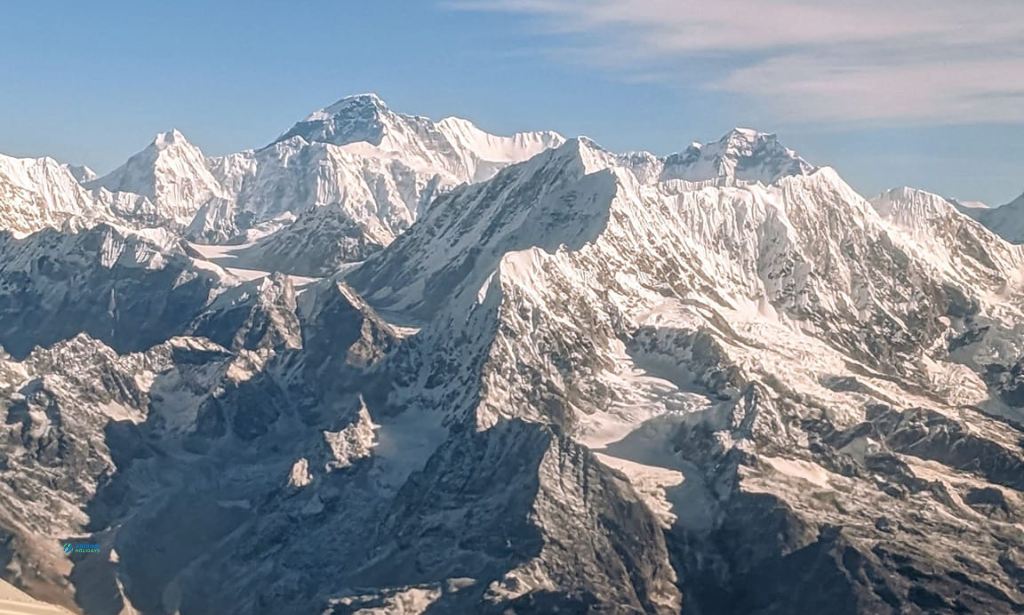
Best Time to Choose Each Option
Picking the right season makes sure you get the best views, safer conditions, and a way more fun experience, whether you’re doing the mountain flight or trekking to Base Camp.
Mountain Flight: All Year, but Clearest in Spring/Autumn
You can take the Everest mountain flights any time of the year. But spring (March-May) and autumn (September-November) are the best because the skies are super clear and the mornings are calm, which means awesome panoramic views of Everest and the nearby mountains. It’s pretty cold up there, usually between -10°C and 5°C. So make sure to wear warm layers, even for a short flight.
Trek: March-May and September-November Best
The best time for Everest Base Camp trek is in spring and autumn when the trails are safe and the views are amazing. In spring, it’s around 10°C to 20°C at lower altitudes and -5°C to 5°C up high, while in autumn it’s 5°C to 15°C in the middle areas with clear, crisp skies. These times also show off colorful landscapes, making the trek safer and way more beautiful.
Monsoon & Winter Challenges
Monsoon (June to August) and winter (December to February) can be tricky for both options. During the monsoon, heavy rain, clouds, and slippery trails make it hard to see anything for both flights and treks. In winter, it can get cold, with temperatures reaching -15°C to -20°C near Everest Base Camp, making trekking really tough. Flights are more likely to be delayed because of strong winds.
Limited spots open during peak season. Book your Everest Base Camp Trek Package now with Abound Holidays today.
Alternatives You can choose - Everest Helicopter Tour
If you want to get close to Everest without spending days trekking, a helicopter tour is a great choice. It gives you incredible views and a quick adventure in one trip.
- You fly from Kathmandu and can land at Kala Patthar or Everest Base Camp for amazing close-up views.
- The cost is around USD 900-1,200 per person, depending on whether you share the ride.
- It’s perfect for travelers who want a luxurious experience without spending days trekking.
Which One Should You Choose?
If you don’t have a lot of time, the Everest Mountain Flight is perfect. In just a few hours, you’ll be seeing amazing views of Everest and nearby peaks without doing long hikes. It’s tough but rewarding and lets you experience Sherpa culture, stunning landscapes, and the awesome feeling of reaching the base camp.
For anyone looking for a comfortable and stress-free way to see the Everest, mountain flight is the ideal one. You get a close-up views of Mount Everest , the famous Kala Patthar viewpoint, and nearby mountains. Making it perfect for people who want an amazing experience without days of trekking.
Summing Up
Everest Mountain Flight vs Everest Base Camp Trek; choosing between the two really depends on your time, budget, and the adventure you’re looking for. The mountain flight gives you fast and awesome views, where as the trek is a longer adventure with cultural immersion, challenges, and a real sense of accomplishment.
Who Should Choose What
Everest Mountain Flight: Great for families, older people, business travelers, and couples on honeymoon who want to see the amazing Himalayan views without doing any hard hiking. It’s perfect if you don’t have much time, like comfort, or want an easy way to see Mount Everest up close.
Everest Base Camp Trek: Best for adventure lovers, photographers, and people who enjoy learning about new cultures. If you like physical challenges, meeting local Sherpas, and spending days surrounded by huge mountains, this trek gives you an amazing feeling of achievement and discovery.
Begin your unforgettable journey to the Himalayas with out Trekking Packages tailored for your choice of destination. Contact us today.
Check Our Other Everest Base Camp Trek Packages
Everest Chola Pass Trek | Everest Three Passes Trek | Everest Base Camp Short Trek | Lhasa Tour with EBC | Tibet EBC Trek | Everest Helicopter Tour | Everest Base Camp Trek
Learn More About Everest Base Camp
EBC Trek Map | Safety on EBC Trek | Acclimatization on EBC Trek | How Long Is EBC Trek | Everest Base Camp vs Annapurna Circuit | EBC Packing List | Permits Necessary for EBC Trek | Reasons To Do EBC Trek | EBC Trek Difficulty | Best Time for EBC Trek
FAQs
Is the Everest Mountain Flight worth it?
Yep! It’s perfect if you just want a fast, amazing view of Everest without doing any trekking. It’s really easy and super fun, making it great for short trips, families with kids, or anyone who wants to see the mountains without all the hard work.
How difficult is the Everest Base Camp Trek compared to a mountain flight?
The Everest Base Camp Trek is challenging and needs several hours of hiking every day, usually on steep and uneven trails. You also need rest days to adjust to the high altitude safely. On the other hand, an Everest mountain flight doesn’t need any physical effort. You just sit and enjoy amazing views of the Himalayas from your seat. So, the trek gives a challenging and full-on adventure, while the flight is an easy and stress-free way to see the mountains.
Do mountain flights fly over the Everest summit?
No, mountain flights don’t fly right over the top of Everest because it’s not safe. Instead, they follow a scenic path along the Himalayas, giving you close-up views of Everest and nearby peaks from a safe distance. You still get awesome photo spots and a clear look at the world’s highest mountain.
Which is cheaper, Everest Mountain Flight vs Everest Base Camp Trek?
The mountain flight costs a lot less, around USD 200 to 250, while the trek is way more expensive, about USD 1200 to 2000 or more.
Can you see Everest clearly from the mountain flight?
On clear days, you get super amazing, nonstop views of Everest and the mountains around it. It feels like you’re flying right above them, and it’s perfect for taking epic photos or just enjoying the jaw-dropping scenery.
Can you get altitude sickness on the Everest Base Camp trek?
Yes! Altitude sickness (AMS) can be a big deal above 3,000 meters. That’s why it’s really important to take rest days to get used to the height and go at a steady pace so your body can adjust properly.
Which is better for photography - Everest Mountain Flight vs Everest Trek?
- Mountain Flight: Perfect for amazing aerial photos, you get everest panoramic views from the plane.
- Trek: Awesome for snapping all kinds of shots, from glaciers and forests to villages and monasteries, there’s tons of variety.
Is the Everest mountain flight safe?
Yes! The flights are flown by skilled pilots, but the schedule really depends on the weather being good and safe for flying.
What happens if your flight is canceled due to weather?
Mountain flights depend a lot on the weather, and they often get canceled if it’s cloudy or stormy. If your flight gets canceled, the airlines will give you a full refund or book you on the next available flight. It’s a good idea to keep your plans flexible and have an extra day in Kathmandu just in case.
Which is safer, Everest Mountain Flight or Everest Base Camp Trek?
Everest mountain flights are usually safer than trekking because you don’t need to do much physical work, and you’re not at high altitudes for long. Trekking is fun and rewarding, but it can be tough with things like altitude sickness, sudden weather changes, and rough paths. Still, with good preparation, a guide, and taking time to adjust to the height, the trek is safe for most healthy people.
Can you combine an Everest Mountain Flight with a short trek?
Yes, definitely. A lot of travelers take a mountain flight to enjoy the amazing aerial views and then go for a short trek around places like Lukla, Namche Bazaar, or Tengboche. This way, you get the excitement of seeing the Himalayas from the sky and also experience Sherpa culture and trekking trails without doing the full Everest Base Camp trek.
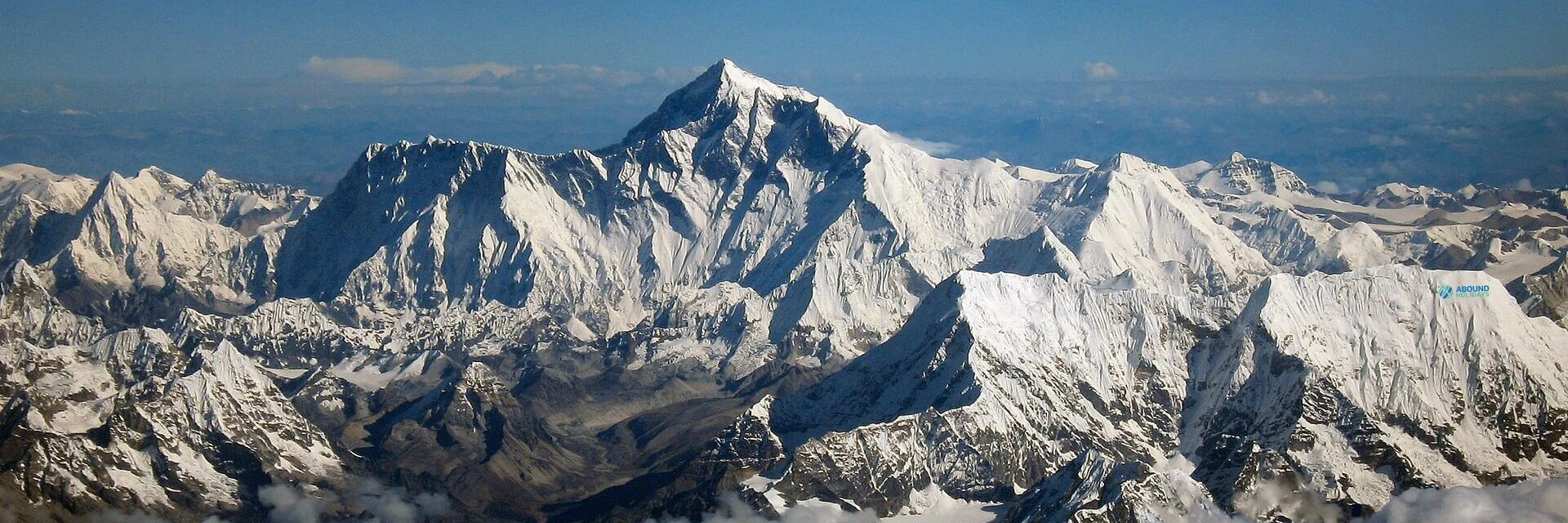
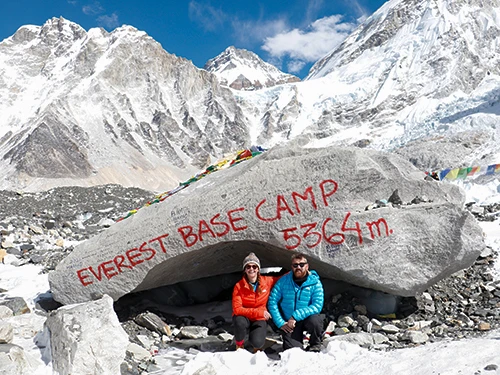
 based on 5 reviews
based on 5 reviews